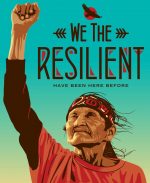My mother was from Wood Mountain Lakota First Nation in Treaty 4 territory in the province of Saskatchewan. She was a street kid who ended up in child welfare after my grandmother abandoned her and her younger brother in a motel room in Moose Jaw when she was five years of age. Due to the fact she was the eldest child, my grandmother left her in charge of her younger brother with specific instructions to ration a loaf of bread and a jar of peanut butter and jam for the five days she had to leave them in search for money.
There were no supports for Indigenous women in the 1930s. There were no social safety nets. There were no human rights. Sexism was rampant and racism was fierce. My grandmother had no one to turn to, especially as an Indigenous single mother, and so she left her children.
I remember my mother telling me how she along with my uncle gleefully ate the loaf of bread, resulting in a complete depletion of their food ration in only one day. Hungry, scared and alone, my mother decided to contact the Children’s Aid Society. At five years old my mother had become so street savvy and, having no other relatives to turn to at the time, contacted the Children’s Aid Society. My mother and her brother needed to eat; they were hungry…
My grandmother’s choice to leave her young children in a room did not stem from a lack of love. My grandmother started living on the streets as a child and eventually became an alcoholic in adult life as a way to deal with the violent genocide she experienced as an Indigenous child and then woman. Dislocated from her family for reasons directly impacted by the Indian Act of 1876 and the institutional disruptions to my family, including residential schools and the child welfare system, she did not have anyone or anywhere she could turn to…
We are the descendants of Sitting Bull, one of the most revered leaders in North America. Our nation’s history in fact has become a Hollywood story, often romanticized in movies like Dances With Wolves which chose to star a Caucasian woman as the leading Lakota lady. Painted in brown theatrical makeup, she was swept off her feet by the white soldier who was part of the U.S. army. They fell in love, and she willingly chose to leave her family to build a new life with this heroic, white settler.
I vividly remember for at least two years after Dances with Wolves was released, any time I mentioned I was Lakota, I would frequently hear, “Wow, Dances With Wolves”. That comment would make me nauseous, because it epitomized the myth of the kind white settler who lived side-by-side with Indigenous peoples resulting in a respectful, lasting and loving relationship: the great colonial lie…
I only met my grandmother twice. The last time was when my mother welcomed her to stay in our home prior to a long operation that would end her life. My mother, in spite of being abandoned in a hotel room, took her mother home. She shared love, compassion, laughter and care with my grandmother in her final days, in spite of her own struggles that resulted from her being a child in care. My mother’s kindness came from a place of non-judgment, a place of love and a place of compassion.
I remember asking my mom how she could take my grandmother into her home when she had abandoned my mother as a child. She responded by saying her mother was pretty much on her own when she was 12. She was completely alone in the world…
That was the most powerful teaching of forgiveness that I have ever heard in my life. As I sit here and think of my grandmother, the very thought of the isolation she must have felt brings me to tears.
(Editor’s note: the author is New Democrat MP for Winnipeg Centre. Ms. Gazan told her story in the Commons in October 30, 2020 debate on Bill C-5 An Act To Amend The Bills Of Exchange Act that would declare each September 30 a National Day for Truth and Reconciliation)






